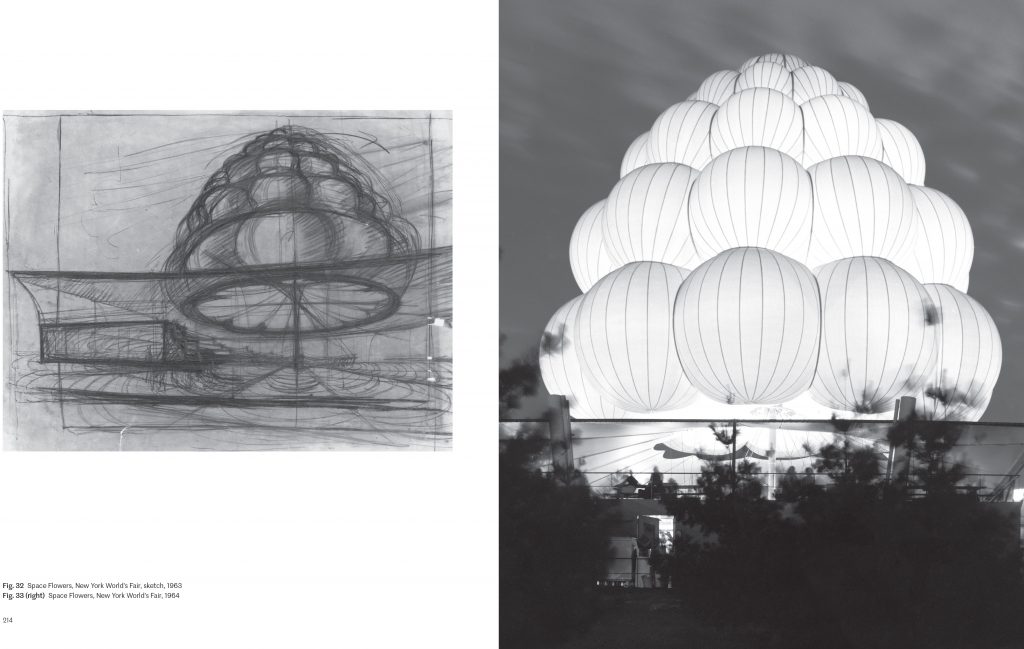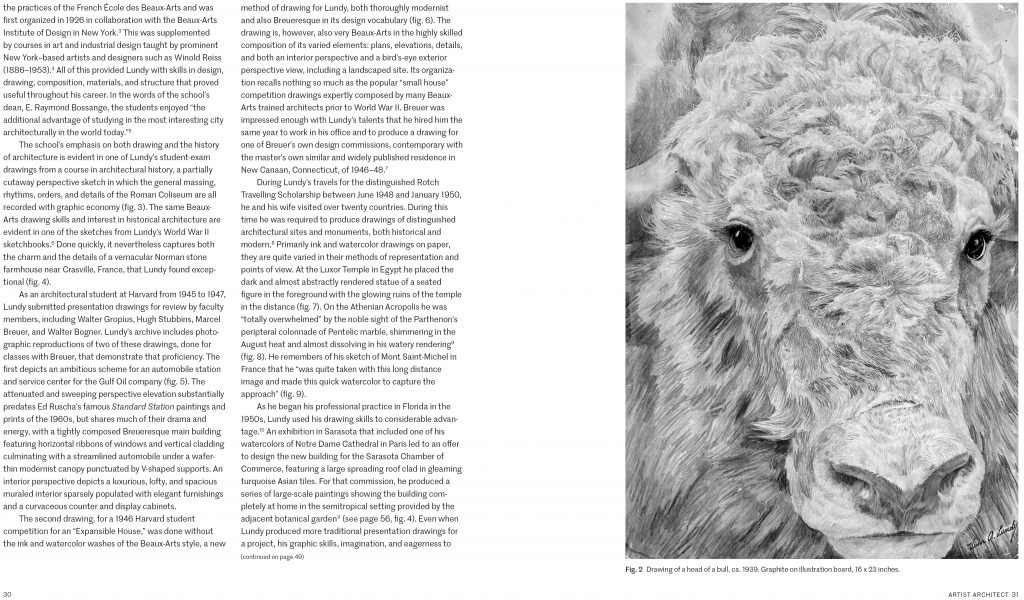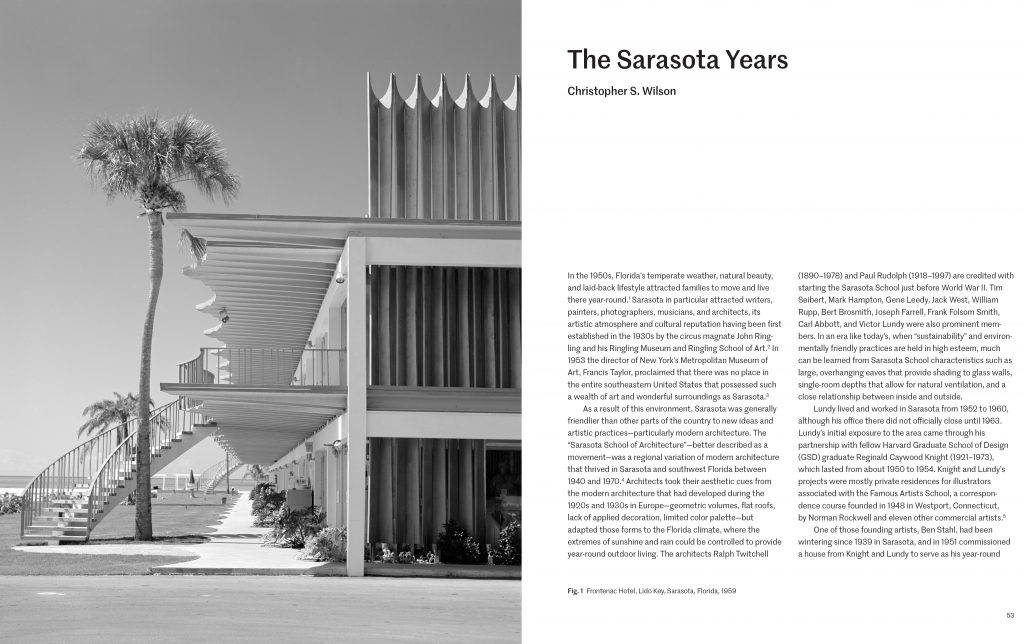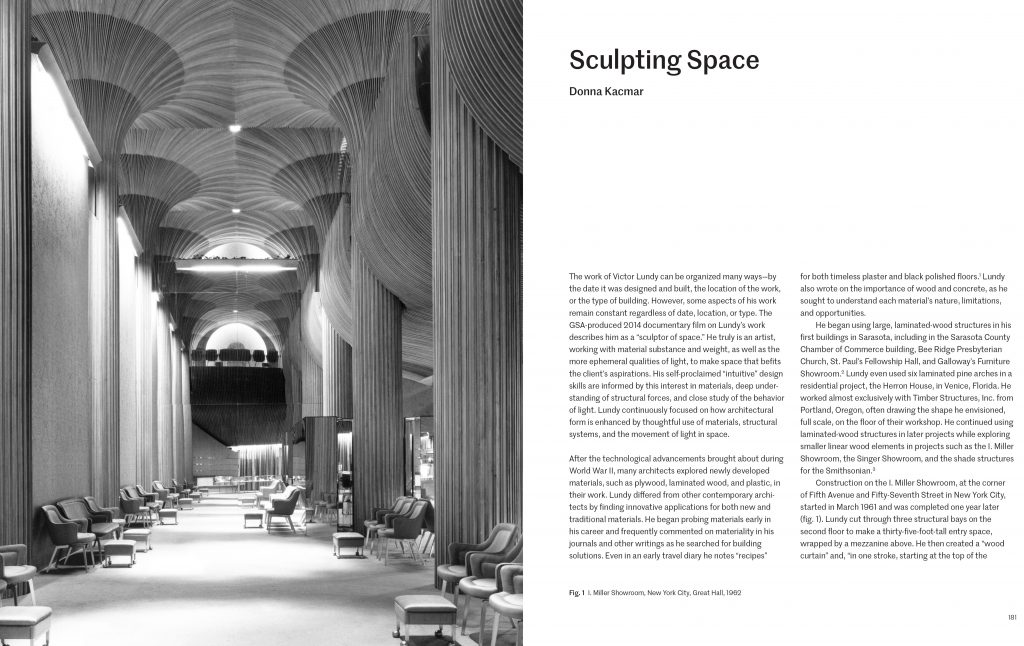***
Title: Victor Lundy Artist Architect
Editor: Donna Kacmar
Publisher: Princeton Architectural Press. 2018. ISBN: 9781616896614
Language: English
250 pages
***
“He truly is an artist, working with material substance and weight, as well as the more ephemeral qualities of light, to make space that befits the client’s inspirations. His self-proclaimed “intuitive” design skills are informed by this interest in materials, deep understanding of structural forces, and close study of the behavior of light. Lundy continuously focused on how architectural form is enhanced by thoughtful use of materials, structural systems, and the movement of light in space.”
“Él es realmente un artista, trabajando con la esencia y el peso de los materiales, así como con las cualidades efímeras de la luz, para crear un espacio que se adapte a los deseos del cliente. Sus autoproclamadas habilidades “intuitivas” para el diseño parten de este interés por los materiales, una profunda comprensión en las cargas estructurales y un estudio preciso del comportamiento de la luz. Lundy continuamente se focalizó en como la forma arquitectónica se ve reforzada por un uso considerado de los materiales, los sistemas estructurales y el movimiento de la luz dentro en el espacio.”
Victor Lundy: Artist Architect (c) 2019 Donna Kacmar, published by Princeton Architectural Press. page 191.

Our initial approach to the book Victor Lundy Artist Architect is with curiosity for an architect that we had barely heard about in the past, a stranger. Nonetheless, the scarce photos that we had seen of his projects showed us a multifaceted architect with an endless capacity to design and precise control over form and materiality. Victor Lundy is a very difficult architect to classify, and it is because of this that Princeton’s Architectural Press book, published at the end of 2018, undertakes for the first time the challenge to condense and interpret his architecture. Lundy, apart from being an architect, was a painter, a professor, a soldier in World War II and a businessman. This book attempts to offer us a broad perspective of his life and work.
Nos aproximamos al libro de Victor Lundy Artist Architect con la curiosidad que nos genera un personaje del que apenas hemos oído hablar, un desconocido. Sin embargo, las pocas fotos que hemos podido ver de sus proyectos nos muestran a un arquitecto polifacético con una capacidad de recursos casi ilimitada para proyectar y un control muy preciso sobre la forma y la materialidad. Victor Lundy es un arquitecto muy difícil de encasillar por lo que el libro de Princeton Architectural Press, publicado a finales de 2018, asume el reto de, por primera vez, de tratar de condensar e interpretar su figura. Lundy, además de arquitecto, ejerció como pintor, profesor universitario, soldado en la II Guerra Mundial y empresario. Este libro tratará de ofrecer una amplia perspectiva sobre su vida y su obra.

After a preface written by Nader Tehrani and a prologue by the author and editor of the book Donna Kacmar, the monograph begins with a brief essay written by the own Victor Lundy where he presents his ideas humbly and straightforwardly. Subsequently, in an essential monograph, Donna Kacmar recreates a journey through the life of the architect. Here we learned that he began his architectural education at New York University learning the academic dogmas of the Beaux-Arts; because of this, after World War II he was able to get his master´s degree with Walter Gropius at Harvard University. It was here, under Gropius’ tutelage, where Lundy assimilated the modern concepts of the Bauhaus. One of the most stimulating abilities of the architect that the book reflects very well is how Lundy incorporated the learned lessons of the previous stages of his life into the following works thus, creating a complex architectural figure.
Tras un prefacio escrito por Nader Tehrani y el prólogo por la editora del libro Donna Kacmar, el libro comienza con un pequeño escrito por el propio Victor Lundy donde expone sus ideas de forma sencilla y directa. A continuación, en un imprescindible capítulo monográfico, Donna Kacmar hace un viaje a través de la vida del arquitecto. Aquí descubrimos que Lundy comenzó su educación arquitectónica en New York University siguiendo los dogmas academicistas de la Escuela Beaux Arts; y así, tras el fin de la segunda guerra mundial pudo realizar un máster con Walter Gropius en la Universidad de Harvard. Fue allí, bajo la tutela de Gropius, en donde Lundy asimiló los conceptos modernos del modelo de la Bauhaus. Uno de los rasgos más interesantes del arquitecto que el libro refleja de forma muy clara es como en cada etapa de su vida contagia a la siguiente incorporando lo aprendido a lo nuevo que está por descubrir.

More importantly, he was always drawing, because if there is something that could define Victor Lundy through his career is his love for drawing. That is the reason the next chapter, written by C. Ford Peatross, traces a second biography of the architect through the perspective of the drawer. This text is essential to understand Lundy´s approach to design, although there is some overlap with the previous chapter.
Más importante aún, siempre estaba dibujando, porque si algo define a Victor Lundy a lo largo de su carrera es su amor por el dibujo. Es por ello que el siguiente capítulo del libro, escrito por C. Ford Peatross, se centra en una segunda biografía del arquitecto vista desde la perspectiva del dibujante. Este texto es fundamental para entender la manera de proyectar de Lundy, aunque existe repetición con respecto al capítulo anterior.
After this, the book will be a back and forth between the figure of the architect and the book’s structure. There are inspiring moments like the chapter written by Christopher S. Wilson ‘The Saratosa Years’; this is possibly the best part of the book and Lundy´s work. During this time, the architect was able to condense the knowledge and abilities that he acquired in his youth into a novel and eclectic architecture; here Lundy was able to host under one concept both the rigor and modernity of the Bauhaus model and the refined classicism of the Beaux-Arts school, while also adapting to Florida’s warm climate.
A partir de este momento la lectura del libro será un tira y afloja entre la figura del arquitecto y la propia estructura del libro. Pasaremos por momentos de éxtasis, con el capítulo escrito por Christopher S. Wilson ‘Los años de Sarasota’, quizás la mejor parte de libro y de la obra de Lundy. Durante este tiempo, el arquitecto consiguió sintetizar los conocimientos y habilidades aprendidas en su juventud en un tipo de arquitectura novedosa y ecléctica; aquí Lundy demuestra que es capaz de aunar bajo un mismo concepto la rigurosidad y modernidad del modelo de la Bauhaus con el clasicismo depurado de la Escuela Beaux Arts, adaptándose además al caluroso clima de la Florida.
Moments of serenity can be found in Christopher Domin’s text ‘Sacred Spaces’, here Domin explains with great rigor and detail the ecclesiastic works where the architect made his greatest projects. There are also some disappointing or unexciting parts that discuss Lundy’s institutional projects in Washington and Sri Lanka. The book has an exciting ending with formally attractive projects such as the Miller Showroom and the Space Flowers pavilion, both in New York.
Momentos de más serenidad son alcanzados en el texto Christopher Domin ‘Espacios sagrados’, aquí se explican con gran rigor las obras eclesiásticas en donde el arquitecto alcanzó sus mayores logros proyectuales. Incluso hay momentos de cierta decepción o aburrimiento que discuten los proyectos institucionales de Lundy en Washington y Sri Lanka. El libro termina con muy buen sabor de boca mostrándonos proyectos formalmente más atractivos, tales como el Showroom Miller o el pabellón ‘Space Flowers’, ambos en Nueva York.

Princeton Architectural Press takes on the difficult task of publishing the first book about Victor Lundy and does it with remarkable success. The book is generously illustrated with full-page photographs and original drawings providing this monograph with a significant and instrumental value since it allows us to study in detail most of Lundy’s built projects. The main critique of the book may be a lack of coordination between authors this provokes certain repetitive themes along the book, as well as a shortage of depth in the critical approach to Lundy´s work. Nevertheless, it is important to point out that this book provides a considered analysis of Lundy´s life and projects. Victor Lundy Artist Architect is a necessary read to understand the work of an indispensable American architect of modern history.
Princeton Architectural Press asume la difícil tarea de publicar el primer libro sobre Victor Lundy y lo realiza con un éxito notable. El volumen está generosamente ilustrado con fotografías y planos originales a página completa otorgando a esta monografía un valor significativo e instrumental, ya que nos permite estudiar en detalle la mayoría de proyectos construidos por Lundy. Las mayores críticas al libro podrían ser una descoordinación entre autores lo que provoca una cierta repetición de temas a lo largo del libro, así como una falta de profundidad crítica en la obra de Lundy. No obstante, es necesario remarcar que, al terminar de leer este libro, uno conoce la obra de Lundy en profundidad, y entiende de qué manera su vida personal afectó su arquitectura. Victor Lundy Artist Architect es un libro obligatorio para entender la obra de un arquitecto imprescindible dentro de la historia moderna de Estados Unidos.
Cover Photo by Victor Lundy: Artist Architect (c) 2019 Donna Kacmar, published by Princeton Architectural Press. Reprinted with permission of the publisher.
English Translation of the article between Hidden Architecture and Margarita Sánchez Urdaneta

